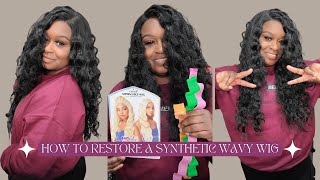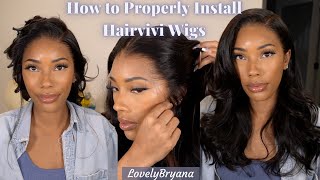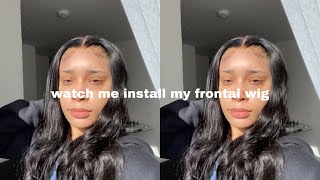Joico Blonde Pixie Cut And Color Tutorial
Vivienne MacKinder discusses the “Three Wheels of Fashion” and shares her razor-cutting techniques to achieve a flirty fringe and perfect pixie haircut in very few steps and hair colorist Philip Ring creates beautiful blonde color with a perfect shadow-root using JOICO's Blonde Life Lightener and LumiShine Demi-Permanent Liquid Color and Developer in four must have formulas.
See more:
http://www.joico.com/joico-products/ha...
http://www.joico.com/joico-products/k-...
( upbeat music ), An incredible consultation is the key to success in the salon., I'm Vivienne Mackinder, and that's the secret behind Salon Ideas by Joico.. It all starts with something we call the three wheels of fashion., A ground-breaking new technique that, let's you dive deep into a consultation allowing you to hone in on your client's, true style and design, looks that are beautiful, modern and perfectly customized.. You'Ll learn the subtle differences between someone who is classic or simply edgy, a client who leans towards romantic, looks and never sexy, ones. You'll even pick up on how influenced they are by trends and friends.. Watch this unique approach in action as I transform hair and show you how to create wearable fun on-trend looks that we know your clients will love to wear. Throughout your career. I'M sure you've learned about face, shape, eye and skin color and how to analyze the hair.. These are the physical aspect of your client and, although important they do not carry the weight that her firmly held beliefs about herself do. Things like her level of femininity, the volume of her presence when she walks in a room or to which tribe of style she Belongs are the key to understanding what looks she will love and which she will feel are just not her.. A woman may have one cut and color, but she certainly doesn't have one style. Trends may come and go, but the trick to making your clients truly happy and creating gorgeous expensive-looking cuts and color is all about taking a laser-sharp look at the client who's sitting. In your chair. Wheel, one conform or non-conform. Is your client and guest, an introvert or extrovert In this wheel we question how quiet or loud the color and style should be to fit the personality of your client. Wheel, two fashion and lifestyle.. Today'S fashion has so many faces that melt into our lifestyle choices and personality.. It is very important to determine where your client lives within the sense of style, for example, hippie rock and roll classic or trendy. Wheel. Three, the sensuality of a woman. From boyish to feminine sexy or glam. When we meet the client in the landscape where she lives, we design inner and outer beauty.. Now, let's apply the three wheels to my client Emma.. You can see in her signature look she's a combination of extrovert trendy, chic sensual.. Now for her cut and color. Who says short, hair can't be versatile and feminine. The razor and the short disconnected cuts. Allow for adaptability. Joining me on her shadow-shift color is Joico influencer and CosmoProf team member Phil Ring and Joico guest artist, Gion Vincent For Emma's. Look. He focus on transitional melting., Perfect for the client who wants to transition from a foil to a well-blended technique.. It'S great to spice up your client's look from a beautiful traditional blonde to a gorgeous seamless, look. Sectioning., Take a horseshoe parting around the parietal ridge to just under the crown. Razor cutting. Step. One. The cut is the Emma. Study the hairline and determine if it will look more beautiful, tight or soft and wispy. Start in the center-back. Hold the section in a vertical angle and step back to study the shape before you cut.. The nape should be the shortest area. Building to a longer top. Work in small sub-sections, as you razor down towards the nape for control. Hold the head. Taut use your fingers to check for the texture and length. Cut to desired length. Step two taking vertical sections work to one side. Step. Three use the chisel method under the occipital bone.. It'S a tiny vibration with a flexed and relaxed thumb.. The wrist elbow and shoulder are kept quiet.. The elbow is relaxed and down.. The feeling, in the hand, is likened to painting the face with a makeup. Brush. You'll. Also use the edging method, as you climb up the head. Rock the razor through each parting, to etch out the layers and design to create movement and texture at the same time.. Moving from tighter to soft textures you'll follow the natural hair shape. Stand to the side. So you can see the silhouette. Using the razor allows you to create shape and texture at the same time.. Therefore, you don't need to go back and texturize at the end of the cut.. Follow the head shape and playing with the hair allows you to cut the hair to the personality of where it lives.. Let the hair talk to you.. The hairline is scruffy sexy, soft and relaxed.. It should not be blunt and static. Make sure the hair stays wet. So your razor can glide through the hair. Step. Four, don't stand on top of the work. Glide when you cut the hair and be gentle.. This allows you to keep control and create beautiful texture. Cut the hair with a traveling guide. Step. Five hair should be pulled out from where it lives. Clip. The next section. Out of the way for control., Then continue walking around the head shape, as you cut.. The second section is brought to the first, and the third is directed to the second, and the fourth is slightly over-directed to the third, leaving a little weight behind the ear. Step. Six be mindful to retain the corner behind the ear by over-directing away from the ear section, as mentioned in step. Five.. Failure to do so will result in a hole at the ear. Step, seven style the hair into place while cutting to make sure it is laying correctly. Work to the back of the ear and then repeat on the other, side. Tip, stop and step back. Use your Mirror to study the shape. Body of movement and placement is key to watching the shape evolve. Step eight when working on the other side flip your hand, so it is parallel to the head. Tip when working on compromised hair use, Color Therapy, Luster, Lock spray Multi-Perfector. Step. Nine using the razor-over-comb method glide over the surface, to reduce weight in the nape. To perform this method, create a very clean comb. Section. Hold the fine-tooth comb horizontal to the design line on a slight angle and put the razor in front of the comb. Glide. The razor and comb at the same time to blend the area together and soften the shape., Then use blunting technique to cross-check your work. Hold the blade parallel to your fingers and pull the blade upwards. Tip blunting up, creates softness. Blunting down, creates bluntness. When cross-checking run. Your fingers, through the hair on both sides to check for evenness. Etch through the hairline to create softness rocking the razor through each parting, to create movement and texture at the same time., Step 10 working in vertical sections start from behind the ear working, forward. Over-direct. The sections away from the face on a soft angle., The more you over-direct, the longer the front sections, will be. Take a guide from the back section and work towards the front. Step. 11 hair gets longer as you move forward.. When you get to the front the sections get more angular., Step - 12 repeat on other side, but leave the right side longer.. This can be adjusted for your client's part preference or cowlick.. On this cut, the right-side front was cut more vertical, which leaves it longer than the left side, which was cut more angular, leaving it shorter.. Step 13 in the temple area. Do a bit of face framing to soften the front sides so that they fall around the eye level. Dry, the back and sides. Step 14 start on the right side. Use the L-technique. Hold the razor vertical to the head and carve on the side of the razor vertically and then transition into a horizontal or L-shape. J-shape for left-handed artists.. Using this method, take a horizontal section to the back. Hold the section horizontally working in the mid shaft. Razor down to etch out layers and the hairline at the same time. Determine the length by cheekbone to the top of the occipital bone. Step 15 blend the top Layers from the back into the side outline shape. Step 16 continue working until the right-side top is completed., Step 17. Repeat the blend from the back into the sides on the left, side. Make sure to follow the head shape and your guide. Remember on this cut. The left side is shorter. Step 18. The L-technique creates valleys and peaks. Hold the razor with a soft bent thumb so that you can glide through the hair.. A locked thumb will force you to be heavy-handed.. Step 19 continue working in the left side until the top left is cut.. This should leave you with an off-center top section that will be cut next.. The top of the graduation is now the base for the top layers. When layering the top of the head turn the blade towards the face and let the back of the blade relax into the palm of your hand.. Keep your elbow down and move your wrist as though you are doing a handshake. Step. 20. Take a center section from crown to front hairline. Over-direct the hair to create an angle of a shorter crown and a longer fringe. Step. 21. Then over-direct, the section back towards you and glide with the etching technique. Next, using an L-technique, create more texture and deeper valleys and peaks. Step 22 continue to over-direct each section back using the etching technique.. When cutting the sides use the L-technique to remove bulk and add texture. Vertically over-direct, the top layers towards the crown working from shorter to longer., Simultaneously build a square layer across the top of the head horizontally from temple to temple.. Step 23. When working on the sides connect the layers with the etching technique for an abstract, connection., Take sections from top of the head forward straight out and cut. Step 24 move the hair around and mold it into shape., Evaluate the length and the thickness of the hair. Use. The butter knife technique to de-bulk the hair, while retaining the perimeter length. Take long light. Strokes. Lay the blade flat onto the hair.. Imagine this angle and lightness of touch as if you were shaving the face.. This style has a deep asymmetric side, sweep so be mindful of the fringe length and make sure that the hair not only sits well but is custom-designed to your client's, face shape., Step 25 to cut the fringe comb. The hair forward and cut short to long left. To right using a deep etching, technique., Step 26 dry, the hair using Color Therapy, Luster, Lock, spray and cross-check.. Since you have been molding the hair into place while you've been cutting, you will be able to study the total silhouette. Now do detailing as needed. Shadow shift. Color. Seductive chic, sexy and playful shadow shift is a color technique created by Phil Ring that combines a base color and a highlight and lowlight all at the same time, in a unique and fun application. To pre-lighten Emma's hair Gion used Blonde Life Lightening Powder with 20 Volume LumiShine developer. Step one starting on the left side at the parietal ridge. Take horizontal weaves and apply formula one. Place the lightener where it is needed and avoid the already lightened pieces. Step. Two take a back-to-back weave and apply formula one. Weave out the blonde pieces and highlight the dark. Pieces. Continue taking fine 1/8th inch sections and weave using formula one. Once the head shape, widens, take staggered foils and apply formula one. Step three. Once you reach the natural parting start to take slices in back-to-back staggered foils. Remember to apply the lightener where you need it and not overlap the already blonde pieces. Step. Four continue to take slices and weaves, leaving very little hair in between.. Do this until you reach the middle of the head. Step, five repeat on the other side., It is important to only lighten the areas that need to be lightened. Step six in the longest part of the fringe, take back-to-back partings in a staggered, foiling method or brick-laying. Method. Step seven place a few vertical slices in the back right at the point of disconnection three to five, depending on density. Step, eight process until hair reaches the palest yellow. Rinse and remove with K-PAK Color Therapy. Shampoo and conditioner then dry. The hair. Next we'll use three formulas. The base formula. One is LumiShine demi-permanent, liquid color 6SB, with 5 volume, LumiShine developer. Formula. Two is LumiShine: demi-permanent, liquid color 8SB, created by equal parts, 7SB plus 9SB, with 5 volume, LumiShine developer. Formula. Three is LumiShine demi-permanent, liquid color 10SB, with 5 volume, LumiShine developer. Next section around the parietal ridge, down the middle and across the crown. Step. Nine starting in the nape apply a shadow root, approximately one to two inches from the scalp using a teardrop application. One inch in front and two inches in the back with base formula one. For a seamless blend apply the color horizontally in 1/8th of an inch sections. Step 10 apply the shadow root until you reach the crown area where the highlight begins. Step 11. Once you get to the top of the section melt, the base formula, one into formula three., Do this for the front sides too. Place in foil and use a dry brush to melt. Comb through to blend. Step 12, when working in the sides take vertical sections. Apply Base formula one and melt into formula three. Using your hands, massage the point, the two colors meet and melt the two formulas: together. Continue this melting technique. Until you reach the front. Step 13, when working into the front, the hair will become shorter and shorter.. As this happens, your application will have less of a base formula. One and more of formula three. Step 14 place a foil on top to protect the sections and repeat on the other side. Step 15 move to the top section of the head apply the shadow root using base formula one to the entire crown section. Approximately one inch out from the scalp. Step 16 take horizontal 1/4-inch, sections. Comb, the section to tease the root area apply more of the shadow root base formula one. Step 17, then weave out a horizontal sub-section. Step 18 apply formula two to the bottom of the section.. This will melt the shadow root gold foil. Step 19. On top of the section apply formula three to the ends: silver, foil. Repeat this technique in the crown sections, two more times. Step. 20 continue working this technique into the side of the top right side. First then, left. Step 21 adjust your melting technique to the length of the hair. Repeat on the other side.. The patterns are formula one formula: two and formula three. And formula one and formula three. Process for 20 minutes at room temperature., Then rinse well, and shampoo and condition with K-PAK Color Therapy.. The outcome is gorgeous.: We've create our vision according to the three wheels of fashion, which for Emma was extrovert, trendy, chic and sensual., And that is Salon Ideas by Joico.. There are five other videos within this collection that will inspire your creativity and what you do in the salon: every day. For more tips and techniques, download the JoiColor System app., I'm Vivienne Mackinder, thanks for watching





Comments
Christine H: I’m confused. For the 3 formulas it’s in the silver blue joico category of toners? Can someone verify that’s correct for me, please. I would hate to use the wrong product on a client : )
Christopher Mitchell: I love Vivienne Mackinder! ! LEGEND! Great video y'all!
Daca Marjanovic: Wow. Brilliant.
Gso Gso: Brilliant my Hair Quenn...thank you
Buzz Cut: WONDERFUL
Hello T: Good technique
Claire Stratton: Fantastic razor cutting